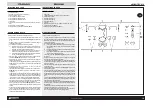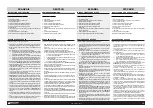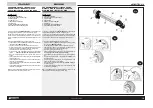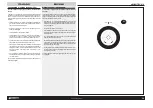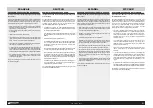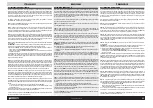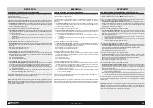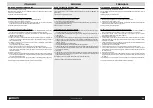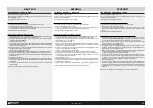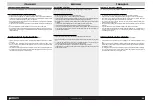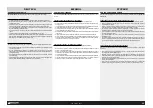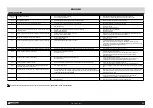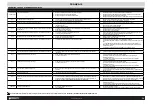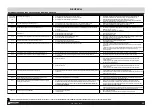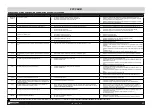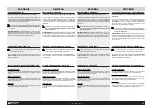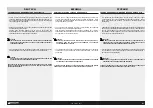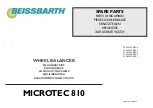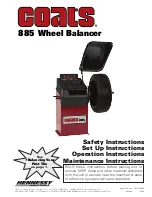
ITALIANO
ENGLISH
FRANÇAIS
28
COD. 653628 Rev.0
CONTROLLO EQUILIBRATURA
Sono neccessari
due metodi di prova
per assicurarsi che l’equilibratura avvenga in modo perfetto.
PROVA DI BUON FUNZIONAMENTO DELLA BILANCIATURA
»
Si equilibrano sulla macchina i due lati della ruota, seguendo le istruzioni.
»
Quindi si produce artificialmente uno squilibrio, applicando un peso di 50 grammi su uno dei due lati.
»
La macchina allora deve indicare esattamente questo squilibrio, sia l’entità che la posizione, mentre
può esservi un’indicazione massima di 5 grammi per l’altro lato.
»
Per controllare la posizione dello squilibrio si gira la ruota sulla posizione di squilibrio indicata dalla
macchina tramite i diodi luminosi.
»
In tale posizione, il peso di prova applicato deve trovarsi verticalmente sotto l’asse di rotazione (ore
6).
»
Se vi sono delle deviazioni angolari chiaramente visibili, occorre ritarare la macchina.
»
Se si verificano deviazioni inaccettabili sull’entità di squilibrio indicato, per il lato della ruota dove è
applicato il peso di prova oppure c’è un’indicazione eccessiva sull’altro lato della ruota, bisogna
ritarare la macchina.
PRECISIONE DI CENTRATURA (QUALITÀ DI EQUILIBRATURA)
A tal scopo si può impiegare la ruota già equilibrata nella prova precedente.
»
Togliere il peso di prova. Quindi sbloccare la ruota dall’attrezzo adattatore e ribloccarla, ma spostata
di circa 35°.
»
In un lancio di prova, l’indicazione non deve superare un massimo squilibrio di 10 grammi su ogni
lato (15 g in caso di ruote particolarmente pesanti). Questo errore è dovuto alle tolleranze nella
centratura del cerchio.
»
Una centratura precisa è essenziale sia per questa prova che nella normale procedura di equilibratura.
»
Se in questo lancio di prova si rileva uno squilibrio elevato, bisogna controllare l’usura, i giochi e la
sporcizia delle parti impiegate per centrare la ruota.
BALANCING CONTROL
Two test processes
are needed to guarantee that the balancing is perfectly performed.
CHECK FOR GOOD BALANCE RESULT
»
Balance both sides of the wheel, following the instructions.
»
Apply a 50g weight on one of the two sides to create an unbalance.
»
The machine should exactly indicate this “artificial” unbalance both in terms of entity and position;
there may be a maximum 5 gram indication relating to the other side of the wheel.
»
Rotate wheel to the unbalance position indicated by the machine LEDs to check the position of
unbalance.
»
In this position, the test weight should be vertically below the rotation axis (6 o’clock).
»
If there are clearly visible angular deviations, the machine must be recalibrated.
»
If there are unacceptable deviations on the unbalance entity indicated for the side of the wheel on
which the weight is applied, or there is an excessive indication on the other side of the wheel, the
machine must be recalibrated.
CENTRING PRECISION (BALANCING QUALITY)
For this operation the already-balanced wheel used in the above test can be re-used.
»
Remove the test weight. Unlock the wheel from the adapter and lock it again after moving it by about
35°.
»
In a test run, the indication must not go above a maximum unbalance of 10g per side (15g for
particularly heavy wheels). This error is due to rim centring tolerances.
»
Precise centring is essential both for this test and for normal balancing procedures.
»
If large unbalance is revealed in this test, check for wear, play and dirt in the parts involved in the
wheel centring operation.
CONTROLE DE L’EQUILIBRAGE
Pour s’assurer du parfait équilibrage,
deux méthodes d’essai
sont nécessaires.
ESSAI DU BON FONCTIONNEMENT DE L’EQUILIBRAGE
» Les deux côtés de la roue sont équilibrés sur la machine en suivant les instructions.
» Produire un balourd artificiel, en appliquant une masse de 50 grammes sur l’un des deux côtés.
» La machine doit alors indiquer exactement ce balourd, son importance et sa position, tandis qu’il
peut y avoir une indication de 5 grammes maximum pour l’autre côté.
» Pour contrôler la position du balourd, tourner la roue sur la position de balourd indiquée par les
diodes lumineuses de la machine.
» Dans cette position, la masse d’essai appliquée doit se trouver verticalement sous l’axe de rotation
(6 heures).
» S’il y a des déviations angulaires clairement visibles, il faut réétalonner la machine.
» S’il y a des déviations inacceptables sur l’importance du balourd indiqué, pour le côté de la roue où
la masse d’essai a été appliquée, ou s’il y a une indication excessive sur l’autre côté de la roue, il
faut réétalonner la machine.
PRECISION DE CENTRAGE (QUALITE DE L’EQUILIBRAGE)
Dans ce but on peut utiliser la roue déjà équilibrée au cours de l’essai précédent.
»
Oter la masse d’essai. Déverrouiller la roue de l’adaptateur et la reverrouiller, déplacée d’environ
35°.
»
Pendant un lancer d’essai, l’indication ne doit pas excéder un balourd maximum de 10 grammes sur
chaque côté (15 g dans le cas de roues particulièrement lourdes). Cette erreur est due aux tolérances
au centrage de la jante.
»
Un centrage précis est essentiel pour cet essai ainsi que pour la procédure normale d’équilibrage.
»
Si, au cours de ce lancer d’essai il s’avère un balourd élevé, il faut contrôler l’usure, les jeux et la
saleté des parties utilisées pour le centrage de la roue.
Summary of Contents for MICROTEC 810
Page 44: ...MICROTEC 810 N 653332 Rev 2 ...
Page 45: ...MICROTEC 810 N 653333 Rev 3 ...
Page 48: ...OPTIONAL N 653334 Rev 1 ...
Page 49: ......

